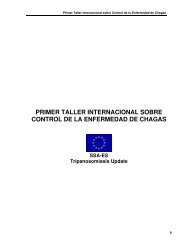El uso de Sistemas de Información Geográfica - CDIA-EC ...
El uso de Sistemas de Información Geográfica - CDIA-EC ...
El uso de Sistemas de Información Geográfica - CDIA-EC ...
You also want an ePaper? Increase the reach of your titles
YUMPU automatically turns print PDFs into web optimized ePapers that Google loves.
<strong>El</strong> <strong>uso</strong> <strong>de</strong> <strong>Sistemas</strong> <strong>de</strong> <strong>Información</strong> Geografica y Sensores Remotos (SR) en Salud Pública<br />
Bogotá, Colombia, 27 al 30 <strong>de</strong> Marzo <strong>de</strong> 2006<br />
prevalence of human infections in the same villages in Colombia. This provi<strong>de</strong>s a<br />
quantitative comparison of the relative importance of the most common vector<br />
species in the region.<br />
The partial overlap between surveys allowed the serological results from<br />
approximately 9,808 children to be linked to infestation prevalence at the village<br />
level. Logistic regression was used to test the association between the probability<br />
of each child being infected, and the proportion of houses in their village which had<br />
sent pots with at least one triatomine of each species (R. prolixus, T. dimidiata.<br />
Tests were carried out both univariately for each species, and multivariately (i.e.<br />
estimates for the effect of each species control for the effect of all other species).<br />
In all analyses, odds ratios were adjusted for the effect of age and sex of the child,<br />
and for clustering at the village level.<br />
Both univariate and multivariate analysis show a significant, and very large, positive<br />
association between higher proportions of houses infested with R. prolixus and<br />
higher probabilities of children being infected (Multivariate analysis Odds ratios for<br />
infection in villages with 1-40% infestation 3.17 (95% CI 1.56-6.46), and for 41-<br />
100% infestation 6.25 (2.07 – 18.91). There is little evi<strong>de</strong>nce for an association<br />
with other vector species, and there is a suggestion of a negative effect of some<br />
vector species.<br />
The strong correlation with R. prolixus is expected, but the data presented here add<br />
a direct epi<strong>de</strong>miological measurement of their importance. None of the other<br />
species is usually consi<strong>de</strong>red as efficient a vector as R. prolixus, mainly because<br />
they tend to be more abundant in the peridomestic rather than domestic<br />
environment. It is surprising, however, to find no consistent evi<strong>de</strong>nce that infection<br />
rates increase with higher levels of infestation of any of the other species. The<br />
results should be treated with caution, both because the sample sizes for these<br />
other species are smaller than for R. prolixus, and because these results appear to<br />
contradict evi<strong>de</strong>nce for the vectorial importance of some other species (notably T.<br />
dimidiata) in other locations. This should be further explored by <strong>de</strong>tailed analysis of<br />
these data, and potentially new studies in areas with single species and with mixed<br />
63




